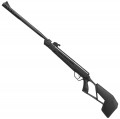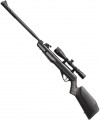Muzzle velocity
The muzzle velocity provided by the rifle - that is, the speed of the bullet as it exits the barrel.
All other things being equal, a higher bullet speed provides greater range and accuracy, and also simplifies aiming at long distances: the bullet flies along a smoother trajectory and requires fewer adjustments in height, and the influence of side winds decreases with increasing speed. On the other hand, this indicator directly affects the price of the rifle; and in some countries, legal restrictions on the ownership of pneumatic weapons are also related to the muzzle velocity of the bullet.
As for specific values, in the weakest modern rifles the initial speed does not exceed
150 m/s, and in the most powerful it can be
300 - 350 m/s or even
more(remember, the speed of sound is 330 m/s). In general, for recreational shooting at short distances, this parameter is not particularly important, and detailed recommendations for choosing pneumatics for more specific situations can be found in special sources. Let us only note that in AEG electric drives (see “Type”) the initial speed extremely rarely exceeds 150 m/s, but this is done solely for safety reasons: such “weapons” are intended for military-tactical games and initially involve shooting at people, and the high speed would be unsafe for players even with protective equipment.
It is also wor
...th considering that this indicator is not strictly defined. In any type of pneumatic it depends on the weight of the bullet (the lighter the faster); therefore, in the characteristics it is usually customary to indicate a certain average velocity for standard ammunition (usually weighing 0.5 g, in AEG - 0.2 g). In addition, in multi-compression rifles the actual speed of the bullet is determined by the degree of inflation, in gas-cylinder rifles it is determined by the ambient temperature, and in PCP models it is possible to achieve higher speeds than declared by replacing the air with a special gas (for example, helium). Nevertheless, this characteristic makes it possible to evaluate the capabilities of the rifle and compare it with other models, including those that differ in type.Scope mount
The type of mount for mounting sights provided in the design of the rifle. Most often in such cases we are talking about an optical or collimator sight; and the most popular mounting options are
Weaver/Picatinny rail and
dovetail. Here are their features:
— "Dovetail". This type of mount has a cross-sectional view of an inverted trapezoid (expanding upwards); the clamp on the sight covers this trapezoid from two sides, and the transverse cutouts, unlike the Weaver / Picatinny rails, are not provided for in the design — fixing in place is carried out in other ways. Dovetail mounts were originally used in civilian hunting rifles, as well as in Soviet-style military weapons. Nowadays, due to their simplicity, low cost and versatility, they are extremely common in air rifles. In addition, we note that you can even install a Weaver / Picatinny rail on a dovetail (such rails are available separately) and use a sight with the appropriate type of mount.
— Weaver / Picatinny rail. Fastening in the form of a bar with a T-shaped profile and characteristic transverse slots — they serve to rigidly fix the installed accessories in one place. Technically, Weaver and Picatinny rails are different types of mounts, they differ in the size of the slots; these differences are such that the sights and other “body kit” for the Weaver rails easily get on the Picatinny rail, but the opposite option is far fro
...m always possible. However, in the civilian market, most weapon accessories for such slats are made specifically for the weaver, so this nuance, most often, is not fundamental, and both types of slats are combined into one category.
In general, for a number of reasons, such straps are much less common in air rifles than the dovetail. At the same time, classic pneumatics are most often equipped with Weaver mounts, but in airsoft copies of real weapons, Picatinny rails (or compatible NATO STANAG 4694 rails, also known as RIS 22 mm) can also be used.
— Is absent. The absence of any standard mounts for the sight in the design of the rifle. Most often, this designation means that the rifle is equipped with a classic front sight with a whole and does not require the installation of additional sights. However, there is also a more specific option — pneumatics, in which original mounts are used to install optics or a collimator, which are not related to the standards described above. Such rifles can be supplied with or without scopes; there are even models with non-removable optics, although extremely rare.Swivels
The presence in the design of the rifle
sling swivels — special loops or staples (usually metal) on which the weapon belt is attached. There are usually two such loops — in the front and back of the weapon. In this case, most often the swivels are installed on the underside of the butt and forearm; this design is universal, it allows both right-handed and left-handed people to use the belt with the same comfort. There are also models with a lateral location of the front swivel — usually on the left side of the forearm, under the right-handed hold; however, nowadays in such rifles it is often possible to rearrange the swivel to the other side. So if the pneumatic is bought for a left-hander and it is planned to equip it with a belt, it will not hurt to clarify the features of the sling swivels separately, however, most likely, their design will not create inconvenience.
Magnification
The degree of magnification provided by the rifle's complete optical sight; for models with variable magnification, the entire adjustment range is indicated, for example 3 – 9x.
For sights of this type in general, see "Aiming Device". And several points depend on the degree of increase at once. On the one hand, a higher magnification allows you to better see small and/or distant targets and facilitates high-precision shooting; on the other hand, it limits the angle of view and significantly affects the cost of the sight, and sometimes also its dimensions and weight. And since air rifles are mostly not designed for long distances, the magnification of complete optics in them usually does not exceed 9x, and one of the most popular options is 4x. However, there are exceptions: in powerful high-end pneumatics, you can find sights with a maximum magnification of 24x and even higher.
Actually, the manufacturer most often selects the magnification of optics for the ballistic characteristics of the rifle. So, when choosing this parameter, it often turns out to be secondary, and it makes sense to focus primarily on the muzzle velocity of the bullet and the firing range for which the weapon is designed — usually, the capabilities of complete optics are quite enough for this. It is also worth mentioning the variable magnification sights mentioned at the beginning, which are quite common nowadays — they are somewhat more complicated and more expensive than fix...ed optics, but they allow you to adjust the magnification to the specifics of the situation.
Lens diameter
The diameter of the front lens (objective) in the optical sight, which is equipped with a rifle.
For sights of this type in general, see "Aiming Device". And the diameter of the lens depends primarily on the amount of light entering the scope. Thus, other things being equal, a larger front lens produces a clearer and brighter image; this is especially noticeable in low light. On the other hand, a larger lens is noticeably more expensive, and it also affects the weight and dimensions of the sight; and in bright daylight, the difference from the “smaller” optics may not be fundamental. In addition, recall that the actual image quality is determined by a number of other factors; as a result, high-end optics with a relatively small front lens may well be more effective than a large low-cost model.
In view of the foregoing, it is worth paying attention to the diameter of the lens in cases where the sight is planned to be used in low light conditions — in a dense forest, at dusk, etc. In this case, it is worth considering not only this indicator, but also other features of the optics (and it is best to focus on practical reviews). If the rifle is bought for recreational use in the daytime in good light, the size of the lens will be a purely reference parameter: in such conditions, almost any optical sight works normally.
Parallax setting
The ability to manually adjust the parallax in the complete optical sight of the rifle.
For sights of this type in general, see "Aiming Device". Parallax is a phenomenon that occurs when the shooter's eye is not on the optical axis of the sight (in other words, not strictly in the centre of the eyepiece). In such cases, the reticle in the eyepiece may also shift, and its apparent position may not coincide with the actual aiming point. To eliminate this effect, parallax adjustment is applied.
Any optical sight undergoes such adjustment at the factory. However, the physical features of this phenomenon are such that parallax can only be adjusted for a certain distance to the target; with significant deviations from this distance (more than 30% downward or 60% upward), parallax again begins to appear. So if you plan to use weapons at different distances, then it is best to have a sight on it with manual detuning from parallax. At the same time, it is worth noting that the complete optics in air rifles are usually adjusted to relatively short distances — at which these weapons are used; and deviations from these distances are rarely significant. Therefore, the parallax adjustment in standard pneumatic sights is rare — mainly among powerful long-range models that can deal with a wide variety of distances.



